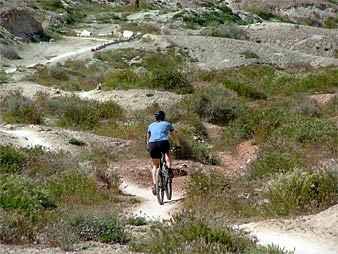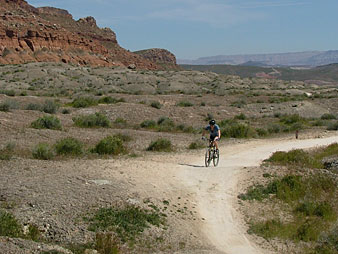
The Bear Claw Poppy Trail starts southwest of St. George in Bloomington, curving up around a bluff into Green Valley. Highlights include a not-too-tough aerobic three-mile hill climb, a couple steep climbs which are better coming down and a fast desert wash. This trail was originally designed to start at the top, but if you are doing an out and back, it is advised to be ridden from the bottom. This trail is a blast to ride, year-round. Bear Claw Poppy is moderate aerobic and intermediate technical. If you don't stop to play, it's also a fairly quick ride -- the 5.5 mile trail can be completed in less than 90 minutes. Younger children can ride the tamer stretches of clay trail on the Bloomington end while more advanced riders can ride all the way to the top and really rip down to the bottom.

Getting there:
Take the Bluff Street I-15 exit in St. George and turn west. Immediately turn south (left) on Hilton Drive. From here you can either follow Hilton Dr by turning left at the first light or go straight on Black Ridge Dr. connecting back to Hilton by turning right at the stop sign.
On Hilton Dr., stay in the left lane and continue on past the golf course. The road will change names from Hilton to Tonaquint Dr. This road will lead you into Bloomington Dr., turn right. Drive through the neighborhood and watch for Navajo Dr. on your right. At the end of Navajo Drive, park just across the cattle guard directly to your right. The "lift-over" in the fence on your right is the start of the trail.
Trailhead
N 37¡ 03.116' W 113¡ 37.362'
End N 37¡ 05.509' W 113¡ 37.689'

The Bearclaw Poppy Trail is a roller coaster style single track trail that contains many challenging steep drop offs. It contains three popular riding loops: Green Valley, Stucki Spring, and the Micro loop. The trail is considered intermediate for mountain bikers, however the Stucki springs loop IS the most dlfficult and the Micro loop along Curly Hollow Road is the easiest. The trail travels to some remote parts of the Red Bluff area, offenng spectacular views of St. George and the surrounding rugged landscape.
- NO MOTORIZED TRAVEL. Except where Posted, this Trail is Closed to Motorized Travel to protect the Endangered Dwarf Bear Claw Poppy, sensitive crypto-biotic soils, and the Virgin River Watershed. Use Caution When Passing a Vehicle on the Curly Hollow Road.

- STAY ON DESIGNATED TRAILS. The desert environment is fragile, and cutting trails destroys vegetation and degrades soils. It can also contrlbute to trail confusion. Many volunteers have worked to restore this environment. Please respect their work.
- PACK IN PACK OUT. Please take home what ever you bring, trash service is not available. If you see trash left by others, pick it up. The trail can only stay clean with everyone's help.
- DON'T HARASS LIVESTOCK. Grazing sometimes occurs near Stucki Spring. Please be considerate of livestock and range improvements.
- RESPECT WILDLIFE. Tortoises and other wildlife are occasionally spotted along the trail. Slow down and observe. DO NOT TOUCH.
- KNOW YOUR LIMITS. All users should be prepared for the elements and know their abilities. Trail difficulty and length should be noted by all. Be aware that lightning and sudden storms can occur. Some areas on the trail are very remote. Know your way back to your vehicle in case of an emergency.
- SHOW TRAIL ETIQUETTE. While this trail is heavily used by mountain bikers, the trail Is open to all non-motorized users. Mountain bikers should practIce proper trail etiquette by yielding to horses, hikers, and trail runners.

Areas of Critical Environmenlal Concern (ACEC)
The BLM has determined that certain public land areas require special management to prevent irreparable damage to resources and may designate such lands as Areas of Critical Environmenlal Concern. In 1999, the Red Bluff ACEC was designated by BLM in the St. George Field Office Resource Management Plan; dated March 15, 1999 (RMP). This ACEC is 6,168 acres in size, contains the endangered Dwarf Bear-Poppy and highly erodible saline soils. These endangered plants and erodible soils are at risk from extensive off-highway vehicle use, road proliferation, human encroachment from adjacent urban areas, and continued pressure for land transfer to accommodate various forms of development. During ACEC designation there were a number of prescriptions applied to protect these vulnerable resources. Some of these prescriptions indude: restrictions on fluid mineral leasing, no fuel wood or mmeral materials sales, restriction of off-highway vehicle use, limiting mountain biking to designated trail and retain this area in public ownership.
 Erodible Soils
Erodible Soils
The Red Bluff ACEC is in close proximity to the Virgin River, a major tributary to the Colorado River. It's BLM's goal to reduce salt In the river by reducing erosion in the Red Bluff ACEC through management prescriptions.
Maintenance of microbiotic crust Is essential in reducing erosion and microbiotic crusts arc commonly found in semiarid and arid environments throughout the world. Microbiotic crusts are also known as cryptogamic, cryptobiotic, and microphytic. Microbiotic crusts are formed by living organisms and their byproducts, creating a surface crust of soil particles bound together by organic materials. Crusts contribute to a number of functions in the environment. These include soil stability and erosion, atmospheric N-fixation, nutrient contributions to plants, soil-plant-water relations, infiltration, seedling germination, and plant growth. Microbiotic crusts are well adapted to severe growing conditions, but poorly adapted to surface disturbances. Domestic livestock grazing, and more recently, such uses as hiking. biking and off-highway vehicle use place a heavy toll on the integrity of the crusts. Full recovery of microbiotic crusts from disturbancesis a slow process, particularly for mosses and lichens.

Unlike other poppys, the Dwarf bearclaw poppy has usually four (rather than six) soft white petals. It is smaller, also, usually less than 10 inches. Its flower stalks are leafy and its leaves are deeply 3-toothed . All bearclaw poppy are gypsum soil loving plants. An endangered lable means it Is the last step before extinction.
The Dwarf bear-poppy was listed as an endangered species on November 6, 1979. Endemic to Washington County, all Dwarf bearpoppy are found within a 10 mile radius around St. George. Within this area it occurs on gypsiferous soil outcrops of the Moenkopi Formation. The main threats to the Dwarf bear-poppy is continued rapid expansion of St. George and surrounding communities and recreational off-highway vehicle use. Management and protection of the Dwarf bear-poppy is provided through a recovery plan (1985), habitat management plan (1986) and more recently, by the St. George Field Office Resource Management Plan; March 15. 1999 (RMP). Among other things, these plans call for monitoring and studies, habitat consolidation, selected fencing, public education, signing, law enforcement, and protection from mining, off-highway travel, and other forms of impacting land uses.

For plant conservation please follow these guidelines
IF YOU WITNESS MOTOR VEHICLE INTRUSIONS OR PERSONS SHOOTING WITHIN THE RESERVE PLEASE CALL 911 OR NOTIFY A BLM RANGER AT 435-688-3200